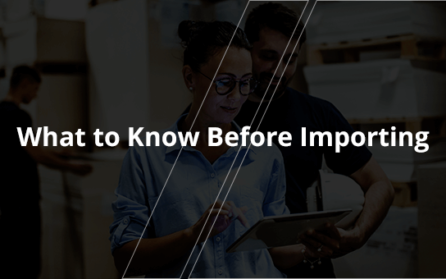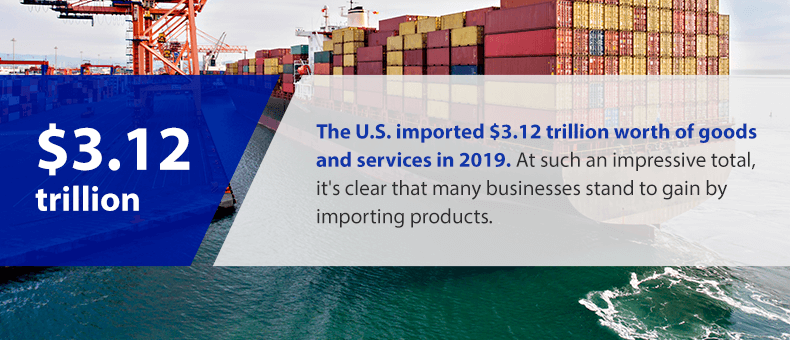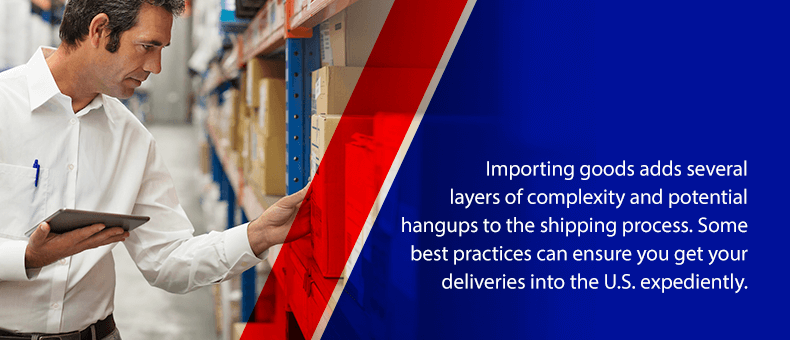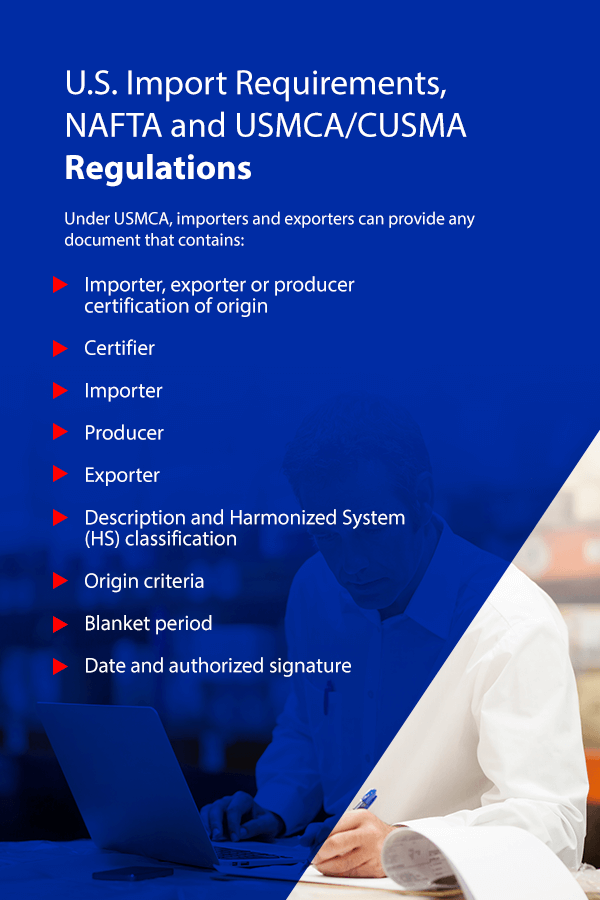Blog
What to Know Before Importing

If you’re used to working with domestic suppliers, the import process might feel like a whole different world. It certainly adds a lot more complexity to your supply chain, as well as unique benefits. If you’ve found a promising supplier, you should feel confident working with them, even if a national border separates you. Our short guide for supply chain managers and logistics experts will teach you what you should know about the U.S. import process.
Importing Basics for Businesses and Supply Chain Managers
The U.S. import process follows a different process and a few extra steps than shipping products within the same county. It starts with a person or a business from the U.S. purchasing goods to have shipped into the country. As usual, small shipments are consolidated into larger containers, traveling by air, truck or rail. Meanwhile, larger loads travel in large containers, often by sea. Usually, companies hire logistics companies versed in importing to deal with the U.S. customs clearance process.
U.S. Customs and Border Protection (CBP) requires the bill of lading provided by the carrier. At least 24 hours before the cargo ships out, CBP should also receive an electronic cargo declaration. This document lists information about the ship’s arrival and what’s aboard. Then, while the ship is in transport, CBP decides if any of the declared items need investigation. If inspecting a shipment, the CBP will carefully examine the merchandise and seize illegal or improperly declared items. The importer may reexport the goods under proper import requirements if applicable.
Once the shipment is permitted for entry, the importer will receive a notice of arrival. Then, the importer must file entry documents at the port within 15 days of arrival, using a formal request for customs release. It often makes sense to work with a customs broker, licensed through CBP, to organize information for the release. Sometimes, all that’s needed is the notice of arrival and bill of lading. Many shipments require a customs bond and other documents, depending on the type of import.
Within 10 working days of entry, the importer must submit an entry summary for consumption and deposit estimated duties. After this step, the importer can pick up the goods at a prearranged destination. Sometimes, CBP will conduct an entry review and revise the duty amount, request more documentation or provide a refund.
Finally, the items will be liquidated. CBP will complete their duty assessment after the imports have been picked up. During liquidation, the CBP will review the tariff classifications and valuation of the goods. When they reach their final appraisal for duties, the amount will be posted, and the importer billed for any tariffs not already paid.
Types of Entry Import Procedures
While the import process follows the same basic steps, there are a few different import methods possible. Before you decide which to use, find out if you can use the simplified informal entry process. The difference between formal and informal entry procedures is:
- Formal: If the shipment is worth $2,500 or more, the formal import process is usually required. These goods are usually for commercial sale, not personal use. Entries need a customs bond, ensuring all taxes and import duties will be paid. When using a formal entry, the importer or broker determines the Harmonized Tariff Schedule (HTSUS) classification and files all customs forms. They also must submit CBP Form 7501 for goods to be released.
- Informal: Goods valued at less than $2,500 may qualify for informal entry. They are usually for personal use, although some commercial shipments can be eligible. The customs officer will handle the HTSUS classification and complete all the necessary forms. In the informal process, the goods are immediately liquidated after release. Goods less than $800 that qualify for Section 321 will not require any duties or fees.
When items arrive through the formal entry process, there are a few entry declaration processes to choose from, including:
- Entry for consumption: The majority of imports fall under entry for consumption. Many items can qualify for immediate delivery with a special permit. Items arriving from Canada or Mexico usually qualify.
- Entry for bonded warehouse: When you want to delay the release of goods, CBP can store them in a bonded warehouse for up to five years. No duties are due until the items enter the market for consumption. This option is suitable for importers storing goods they plan to export since they will not have to pay U.S. duties.
- Transport in bond: When items arrive, they can be transported to another entry point before release. For example, when a southern U.S. business imports from Canada, it may want closer access than the U.S-Canadian border. So, the importer can have the shipment transported via truck to a CBP port in Texas. The carrier must be bonded with the CBP. Once in the desired port, the customs broker can organize the release and ensure duties are paid on time.
Pros and Cons of Importing Goods for Your Business
As your business decides whether to import goods, it’s usually helpful to weigh the advantages and disadvantages of importing.
Benefits of Importing Products to the U.S.
The U.S. imported $3.12 trillion worth of goods and services in 2019. At such an impressive total, it’s clear that many businesses stand to gain by importing products. While some foreign goods are necessary, because the country consumes certain products faster than it can produce them, others offer distinct advantages. Here are some of the pros of importing:
- Better quality: Certain products have a reputation for excellence when they come from a specific region. In some cases, locally grown foods taste better because of the soil conditions or climate. For example, many consumers seek olive oil exported from the Mediterranean, where olives are native. Likewise, Canada is the world’s largest exporter of maple products, and the U.S. imported 62% of their total maple exports in 2018. There’s also a high demand for foreign cars from countries renowned for their automotive manufacturing.
- Higher profit margins: Many countries can produce cheaper goods thanks to an abundance of resources or less expensive labor. For many businesses, importing goods is more affordable, even after duties and tariffs, because of cheaper manufacturing. These companies enjoy higher profit margins than companies sourcing from local manufacturers.
- New products: When innovative products enter a foreign market, being the first to bring them to your own has many advantages. You can gain customers and market share by being the only source of a niche product early on. Even after other companies follow suit, you’ll be the established market leader.
Drawbacks of Importing Products to the U.S.
While importing imposes some disadvantages to U.S. businesses, you can avoid many of the impacts of these issues. Here are some of the cons of importing goods and how your business can limit the risks:
- Customs delays: One reason many companies shy away from importing is because of the customs process. If you’re not used to all the U.S. import regulations, you can find yourself facing a delay at the border. For many businesses following a just-in-time approach, delays at customs can snowball into a major issue. The good news is that you can avoid delays by working with customs and import experts and following best practices when importing your goods.
- Duties and fees: The U.S. government places tariffs on foreign goods to encourage domestic production, to protect customers from dangerous products, for national security and political reasons. In some cases, the extra costs make it more affordable to buy from local producers. You can usually calculate whether it will be cheaper to buy locally or abroad, although it’s not foolproof. Governments can sometimes change tariffs suddenly, disrupting your supply chain. As a U.S. importer, you can enjoy fewer duties when importing from within North America, thanks to free trade.
- Less quality control: Although this is a bigger problem in some parts of the world than others, importing gives you less oversight over your suppliers. You can find yourself importing pirated goods or lower quality products. Whenever you import, be sure to vet your suppliers thoroughly.
Cultural and Economic Factors to Consider for Importing
A few factors that may influence your decision to import products are the cultural and economic impacts. These influences can work to your benefit or disadvantage, depending on the circumstances.
- Foreign exchange rates: When shipping international products to the U.S., consider the ever-changing exchange rates. When the U.S. economy is strong compared to foreign markets, suppliers can sell goods to you at a lower price without sacrificing profit. On the flip side, a weaker U.S. dollar will not go as far in a foreign market, making imports more expensive.
- Tariff fluctuations: Tariff rates can change for many reasons. If the U.S. government suddenly imposes a steep duty on goods from a particular market, you can pay more for your products than expected. This possibility makes importing from Canada to the U.S. more favorable since you won’t usually get charged import duties.
- Political considerations: Political tensions can result in higher trade tariffs between countries. Further, some Americans hesitate to buy items originating from certain countries for political reasons. For example, when countries are known for their poor labor practices, some customers do not want to purchase goods manufactured there.
- Differences in international culture: Cultural differences can affect your supplier relations. Some cultures have negative associations with hard deadlines, which can make planning trickier. It can also influence your supplier’s negotiation styles. Many countries prefer to build strong personal relationships with business associates. In that case, taking the time to get to know and trust your supplier can help you in business deals.
Maximizing Productivity During the Importation Process
Importing goods adds several layers of complexity and potential hangups to the shipping process. Some best practices can ensure you get your deliveries into the U.S. expediently.
A few areas to make the customs process as efficient as possible include:
- Licensing: Usually, businesses do not need a license to import goods, and CBP does not ask for one. Other government agencies issue import licenses for specific products. It’s crucial to determine which permits you need. Take the necessary steps to get your import license through the corresponding agency to avoid delays at the border. How much an import license costs depends on the agency requiring it. Items subject to import licenses include dairy, arms, ammunition, explosives, implements of war, radioactive materials, wildlife and pets, pharmaceuticals and textiles.
- Weights and measurements: The electronic cargo declaration form asks for the weights and dimensions of all imported products. Since you must file this form before the cargo can ship out, knowing this information before importing is crucial. This information also helps you estimate duties and other costs before you get billed.
- Customs brokers: The best way to expedite the customs process is to use a licensed customs broker. These professionals are experts in all the rules on imports and can assume many of your responsibilities as an importer to get items cleared efficiently. They have a presence on both sides of the border to make the entire process as smooth as possible. Purolator International customs brokerage, for example, handles imports from Canada to the U.S., start to finish.
- Transport companies: Not all carriers are equipped to handle customs. A carrier participating in CBP’s Automated Manifest System (AMS) will provide CBP with all necessary documentation electronically for the fastest transport. If you work with Purolator International, we’ll arrange a transport company for you. Our service aims to identify the quickest and most affordable carrier for every shipment and organize all the details.
- Documentation: The CBP needs a lot of information about your imported products. Giving accurate information before your shipment’s arrival lets customs agents review it in advance. If everything checks out, your import can be quickly verified and cleared on arrival. Ensure your supplier provides a printed customs invoice, including all the right information. Include a description, quantity, selling price, freight, insurance, packing costs, delivery terms, payment method, weight and volume of the shipment. Ensure the carrier provides the necessary documents. Also, prepare or have your broker submit the required paperwork when your items arrive at the port.
- U.S. import regulations: Many products have specific import regulations, quota restrictions and duty classifications. Check and double-check all the U.S. import restrictions before you start the process. When using formal entry, you or your broker must declare the correct tariff classifications on all goods.
U.S. Import Requirements, NAFTA and USMCA/CUSMA Regulations
Canada, Mexico, and the U.S. signed the North American Free Trade Agreement (NAFTA) into agreement in 1992. NAFTA established free trade between its member countries. Since then, most tariffs do not apply to goods crossing borders within North America. It allowed importers and exporters to claim preferential treatment at customs. In 2018, NAFTA was renegotiated and replaced with the U.S.-Mexico-Canada Agreement, or USMCA, referred to as CUSMA in Canada. USMCA took effect on July 1, 2020.
Under NAFTA, imports required an official certificate of origin to prove that goods originated in North America. Under USMCA, importers and exporters can provide any document that contains:
- Importer, exporter or producer certification of origin
- Certifier
- Importer
- Producer
- Exporter
- Description and Harmonized System (HS) classification
- Origin criteria
- Blanket period
- Date and authorized signature
For most importers, informal documents like invoices can serve as the certification of origin.
Most of the core principles of NAFTA remain in effect under USMCA. It continues to support the reduction and elimination of duties on North American trade. While there are a few regulatory changes, you can afford many of the same benefits of importing through Canada that you could before. The new rules make importing even more accessible, especially for small-to-medium enterprises (SMEs). To learn more and get your documentation up to speed, reach out to Purolator International.
Simplify the Importation Process With Purolator International
As your business prepares to take in imports from Canada, make things even easier with Purolator International. We’ll handle the entire shipping process on your behalf. It starts with our expert logistics services and coordinating shipment consolidations and carrier transportation.
When your imports reach the Canadian border, you can rest assured knowing our customs brokers have handled all the documentation and prepared the shipment for smooth passage into U.S. territory. You can track your shipment before and after it crosses the border and tap into our PuroTouch premium customer service.
Start importing from Canada today with Purolator International. Reach out to us and let us be your single point of contact for the entire international shipping process.



